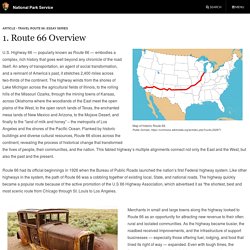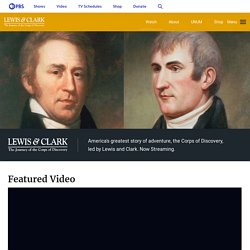

Why The Straight Story remains one of the great American road movies. Travel History: How Americans Fell in Love With Taking Road Trips. Song of the Open Road by Walt Whitman. Afoot and light-hearted I take to the open road, Healthy, free, the world before me, The long brown path before me leading wherever I choose. Henceforth I ask not good-fortune, I myself am good-fortune, Henceforth I whimper no more, postpone no more, need nothing, Done with indoor complaints, libraries, querulous criticisms, Route 66 Official Site, Guides, Maps - National 66. Full documentary about Route 66. Route 66 - National Park Service. Merchants in small and large towns along the highway looked to Route 66 as an opportunity for attracting new revenue to their often rural and isolated communities.

As the highway became busier, the roadbed received improvements, and the infrastructure of support businesses — especially those offering fuel, lodging, and food that lined its right of way — expanded. Even with tough times, the Depression that worked its baleful consequences on the nation produced an ironic effect along Route 66. The vast migration of destitute people fleeing their former homes actually increased traffic along the highway, providing commercial opportunities to a multitude of low capital, mom-and-pop businesses. World War II caused a marked decline in civilian and tourist traffic, but it stimulated new business along U.S. 66, when it acted as a military transport corridor moving troops and supplies from one military reservation to another. There is a spirit, a feeling that resides along this highway.
Family Day Trip - Norman Rockwell - Saturday Evening Post Covers. Going and Coming video. Dorothea Lange. In early March, 1936, Dorothea Lange drove past a sign reading, “PEA-PICKERS CAMP,” in Nipomo, California. At the time, she was working as a photographer for the Resettlement Administration (RA), a Depression-era government agency formed to raise public awareness of and provide aid to struggling farmers.
Twenty miles down the road, Lange reconsidered and turned back to the camp, where she encountered a mother and her children. “I saw and approached the hungry and desperate mother, as if drawn by a magnet,” she later recalled. OMCA COLLECTIONS. Pbs. Sent by President Thomas Jefferson to find the Northwest Passage, Meriwether Lewis and William Clark led the most important expedition in American history.

This extraordinary film tells the remarkable story of the entire Corps of Discovery – not just of the two Captains, but the young army men, French-Canadian boatmen, Clark’s African-American slave, and the Shoshone woman named Sacagawea, who brought along her infant son. As important to the story as these many characters, however, was the land itself, and the promises it held. The mission of the Corps of Discovery was to explore the uncharted West. Beginning February 28, 1803 It would be led by Meriwether Lewis, and Lewis’ friend, William Clark.
Over the next four years, the Corps of Discovery would travel thousands of miles, experiencing lands, rivers and peoples that no Americans ever had before. Lewis and Clark encounter Teton Sioux. Manifest Destiny and the West. In what ways was the US settled and unsettled in the 19th century?

What role did artists play in shaping public understandings of the US West? When you think about the US West, what images and stories come to mind? Shows a vision of settling the United States that in many ways still resonates today. Lewis and Clark - Expedition, Trail & Timeline - HISTORY. The Lewis and Clark Expedition began in 1804, when President Thomas Jefferson tasked Meriwether Lewis with exploring lands west of the Mississippi River that comprised the Louisiana Purchase.

Lewis chose William Clark as his co-leader for the mission. The excursion lasted over two years: Along the way they confronted harsh weather, unforgiving terrain, treacherous waters, injuries, starvation, disease and both friendly and hostile Native Americans. Lewis & Clark: Great Journey West. JACK KEROUAC on THE STEVE ALLEN SHOW with Steve Allen 1959.